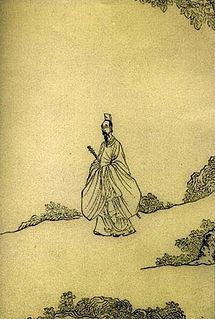 W
WThe Chu Ci, variously translated as Verses of Chu or Songs of Chu, is an anthology of Chinese poetry traditionally attributed mainly to Qu Yuan and Song Yu from the Warring States period, though about half of the poems seem to have been composed several centuries later, during the Han dynasty. The traditional version of the Chu Ci contains 17 major sections, anthologized with its current contents by Wang Yi, a 2nd-century AD librarian who served under Emperor Shun of Han. The early Classical Chinese poetry is mainly known through the two anthologies, the Chu Ci and the Shi Jing.
 W
WThe Classic of Poetry, also Shijing or Shih-ching, translated variously as the Book of Songs, Book of Odes or simply known as the Odes or Poetry, is the oldest existing collection of Chinese poetry, comprising 305 works dating from the 11th to 7th centuries BC. It is one of the "Five Classics" traditionally said to have been compiled by Confucius, and has been studied and memorized by scholars in China and neighboring countries over two millennia. It is also a rich source of chengyu that are still a part of learned discourse and even everyday language in modern Chinese. Since the Qing dynasty, its rhyme patterns have also been analysed in the study of Old Chinese phonology.
 W
WNo Enemies, No Hatred is a book by Nobel Peace Prize-winning writer and activist Liu Xiaobo which contains a wide selection of his writings and poetry between 1989 and 2009. It was published in 2012 by the Belknap Press, an imprint of Harvard University Press. It was edited by Perry Link, Tienchi Martin-Liao and Liu Xiaobo's wife Liu Xia, and includes a foreword written by Václav Havel. The volume marks the inaugural English-language collection of Liu's work.
 W
WThe Orchid Pavilion Gathering of 353 CE, also known as the Lanting Gathering, was a cultural and poetic event during the Six Dynasties era, in China. This event itself has a certain inherent and poetic interest in regard to the development of landscape poetry and the philosophical ideas of Zhuangzi. The gathering at the Orchid Pavilion is also famous for the artistry of the calligraphy of Wang Xizhi, who was both one of the participants as well as the author and calligrapher of the Lantingji Xu.
 W
WCao Cao (155–220) was a warlord who rose to power towards the final years of the Eastern Han dynasty and became the de facto head of government in China. He laid the foundation for what was to become the state of Cao Wei (220–265), founded by his son and successor Cao Pi, in the Three Kingdoms period (220–280). Poetry, among other things, was one of his cultural legacies.
 W
WMao Zedong (1893–1976), the first Chairman of the Communist Party of China and leader of the People's Republic of China for nearly 30 years, wrote poetry, starting in the 1920s, during the Red Army's epic retreat during the Long March of 1934-1936, and after coming to power in 1949. In spite of Mao's political radicalism he was artistically conservative, opting to use traditional Chinese forms.
 W
WQuan Tangshi is the largest collection of Tang poetry, containing some 49,000 lyric poems by more than twenty-two hundred poets. In 1705, it was commissioned at the direction of the Qing dynasty Kangxi Emperor and published under his name. The Quan Tangshi is the major reservoir of surviving Tang dynasty poems, from which the pre-eminent shorter anthology, Three Hundred Tang Poems, is largely drawn.
 W
WThe Rare Book Preservation Society (文献保存同志会) was founded in 1940 by Zheng Zhenduo (郑振铎), Zhang Shouyong (张寿镛), He Bingsong (何炳松), Zhang Yuanji (张元济), and Zhang Fengju (张凤举) for the purpose of secretly acquiring and preserving rare books and manuscripts in the Shanghai Jiangnan region. These cultural assets have been accumulated by a number of famous private libraries some over 1,000 years.
 W
WThe Star Gauge, also known as Xuanji Tu is a Chinese poem written in the 4th century AD. It was written by the poet Su Hui to her husband. It consists of a 29 by 29 grid of characters, which can be read in different ways to form roughly 3,000 smaller rhyming poems. The outer border forms a single circular poem, thought to be both the first and the longest of its kind.
 W
WThe Wangchuan ji is a collection of Tang poetry written by the two poets Wang Wei (王維) and Pei Di (裴迪), also known in other ways, such as Wheel River Collection. The verses are based on a series of twenty scenes, inspired by the sights available at Wang Wei's retirement estate: each one forms the topic for a pair of one five-character quatrains, one by each of the poetic pair, first Wang Wei, then Pei Di. Besides the long-term interest in these verses, in China, this anthology has created much interest around the world, including numerous translations, especially Wang's version of "Deer Park". Several complete translations of the whole work have been done, in English. A series of "Twenty Scenes" of Wangchuan were done as a painting series. The Wangchuan poems form an important part of traditional Chinese Shan shui landscape painting and Shanshui poetry development. There are clear indications of the influence of the Six Dynasties poet early exemplar of landscape genre poetry Xie Lingyun's poems on topics, partly inspired by his family estate, in what is today Zhejiang. The considerable influence of Pei Di and Wang Wei's Wangchuan ji shows in much subsequent painting, music, and poetry.